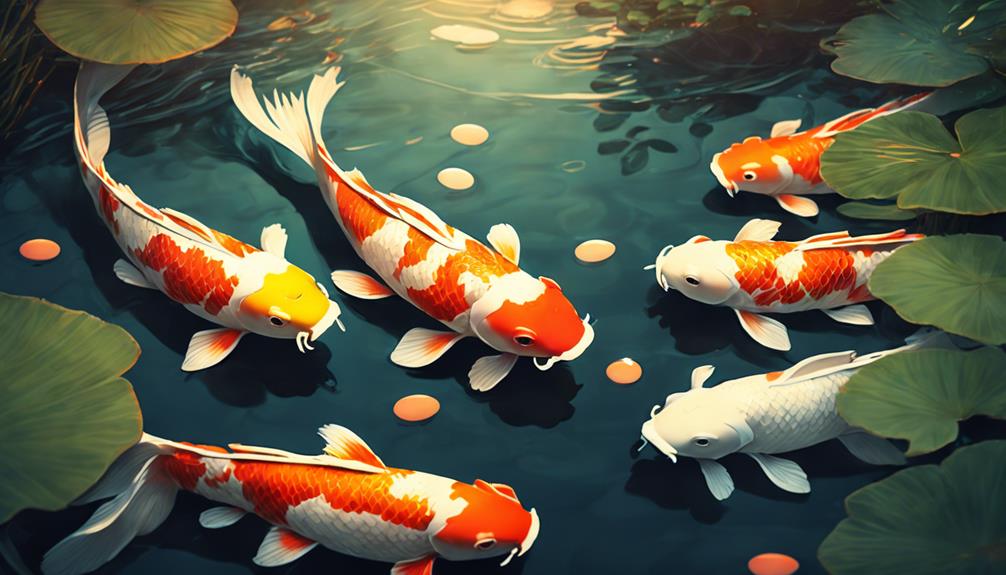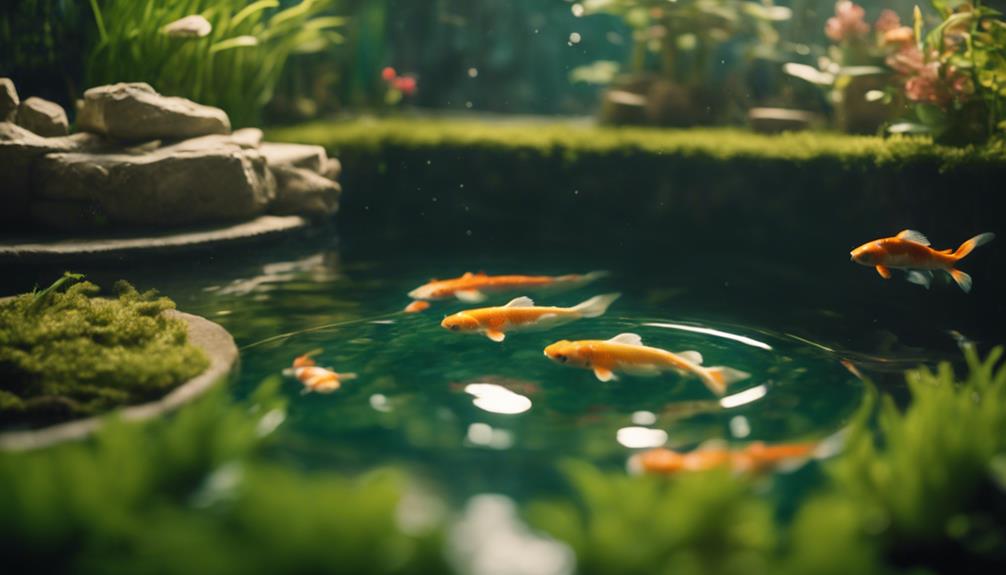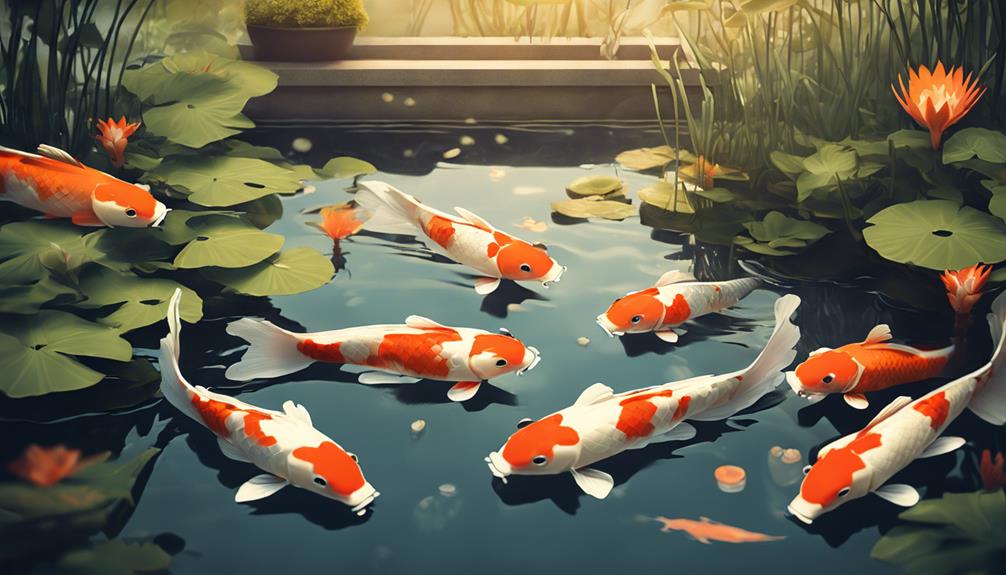You'll increase your chances of successfully breeding koi fish by selecting high-quality breeding stock with robust bodies, vibrant colors, and well-defined scales. Create an ideal breeding environment by replicating natural spawning conditions, maintaining a temperature range of 64°F to 75°F, and providing a large enough pond with adequate water depth, filtration, and aeration. Understand the koi mating process and separate males after spawning to prevent injury or stress. Properly care for koi eggs and fry by providing the right environment and nutrition. Finally, maintain a healthy pond through regular water changes, proper filtration, and monitoring water quality. Now, get ready to take your breeding journey to the next level.
Table of Contents
Key Takeaways
- Select healthy, well-bred parents with robust bodies, vibrant colors, and well-defined scales to produce high-quality offspring.
- Replicate natural spawning conditions, including a temperature range of 64°F to 75°F, to induce spawning in koi.
- Provide a suitable breeding environment, including a large enough pond with adequate water depth, filtration, and aeration, and incorporate plants for shade and shelter.
- Feed koi fry live or frozen foods, such as brine shrimp or infusoria, after the yolk sac is absorbed, and maintain a clean and healthy environment.
- Guarantee a well-maintained pond by performing regular water changes, testing water regularly, and ensuring a well-functioning filtration system to provide a thriving environment for koi.
Choosing the Right Koi
You'll need to select high-quality koi with desirable traits to breed successfully.
There are over 100 recognized Koi Varieties, each with its unique characteristics, patterns, and colors.
To increase your chances of producing high-quality offspring, it is vital to choose healthy, well-bred parents. Look for koi with robust bodies, vibrant colors, and well-defined scales.
When selecting breeding stock, it is pivotal to identify the sex of your koi. Male koi typically have a slender, torpedo-shaped body, while female koi are generally rounder and more egg-shaped.
Males also tend to have a more pointed fin and a thicker, more muscular body than females.
To guarantee genetic diversity, it is recommended to breed koi from different bloodlines. You can purchase koi from reputable breeders or select from your own stock, provided they meet the desired breeding standards.
Creating a Breeding Environment
To induce spawning in your koi and optimize their breeding success, you need to replicate the natural spawning conditions found in their native habitats.
You should focus on maintaining a temperature range of 64°F to 75°F (18°C to 24°C), which is ideal for koi spawning.
Guarantee your pond is large enough to accommodate your koi comfortably, with adequate water depth, filtration, and aeration.
Suspend a spawning rope or a submerged brush in the pond to provide a surface for the koi to deposit their eggs.
Incorporate plants with broad leaves, like water lilies or cattails, to provide shade and shelter for your koi.
Understanding Koi Mating Process

During the koi mating process, males engage in an intricate courtship ritual, chasing and nudging females to induce egg-laying, a behavior that's pivotal for successful breeding.
As you prepare for koi breeding, understanding this process is paramount. Typically, spawning occurs when water temperatures range from 65°F to 70°F, usually in late spring or early summer between May and June.
During this time, males will chase and nudge females to encourage egg-laying, and then fertilize the eggs once they're released. You may notice cloudy or foamy water with a distinct odor during this process.
Females release a pheromone to guide males to spawning locations, and males spit sperm to fertilize the eggs. Notably, this process can be stressful for koi, especially females, so you may need to remove males to protect them from injury or stress.
Caring for Koi Eggs and Fry
After successful spawning, your attention turns to caring for the delicate koi eggs and fry, a vital phase that demands precision and attention to detail to guarantee their survival and ideal growth.
During this phase, a key requirement is to provide the right environment and nutrition for the developing fry.
Some vital tips to keep in mind:
- Feed the koi fry live or frozen foods, such as brine shrimp or infusoria, after the yolk sac is absorbed (around 24-48 hours).
- Maintain a clean and healthy environment with regular water changes and proper filtration to prevent toxin buildup.
- Feed the fry small, frequent meals (3-5 times a day) to prevent overfeeding and encourage healthy growth.
- As the fry grow, gradually introduce larger foods, such as commercial flake or pellet foods, and eventually make a shift to a diet similar to that of adult koi.
Maintaining a Healthy Pond

You'll need to guarantee your pond is well-maintained to provide a thriving environment for your koi, as a healthy pond ecosystem is essential for their overall well-being.
To achieve this, you'll need to keep the water clean and clear by performing regular water changes. Aim to replace around 10-15% of the pond water weekly to remove built-up toxins and waste.
Make sure to test the water regularly for ammonia, nitrite, and nitrate levels to confirm they're within safe ranges for your koi.
A well-functioning filtration system is also pivotal for maintaining a healthy pond.
Regularly clean and maintain your filtration system to verify it's working efficiently.
You should also monitor the pond's water temperature, as koi are sensitive to extreme temperature fluctuations.
Keep an eye out for signs of algae growth, which can deplete oxygen levels and harm your koi.
Frequently Asked Questions
How to Successfully Breed Koi?
To successfully breed koi, you'll need to focus on ideal Koi Nutrition, maintain impeccable Water Quality, and understand Breeding Cycles, ensuring a healthy environment for your fish to thrive and produce high-quality offspring.
What Should You Do First Before Attempting to Breed Koi?
Before diving into the world of koi breeding, you'll want to take the first step: selecting healthy, compatible koi, preparing pristine water, and setting up a suitable tank to guarantee a successful spawn.
How to Breed Expensive Koi Fish?
You'll want to focus on Koi selection, understanding fish genetics, and mastering breeding techniques to produce high-value offspring. Select parent fish with desirable traits, consider cross-breeding, and provide ideal conditions to increase the chances of expensive Koi.
How to Encourage Koi Spawning?
Did you know that koi can live up to 25-30 years in ideal conditions? To encourage koi spawning, guarantee your fish have reached maturity (around 3-5 years), provide spawning triggers like underwater plants and perfect water quality, and maintain a temperature range of 65-70°F.
Conclusion
You've made it to the final step of koi breeding, and now you're just a few flips of the fin away from raising a school of champion koi!
By following these essential tips, you'll be swimming in a sea of success, with koi babies galore.
Remember, breeding koi is a delicate art, but with the right know-how and attention to detail, you'll be the envy of every koi enthusiast around.
So, plunge ahead and get ready to reap the rewards of your hard work!

